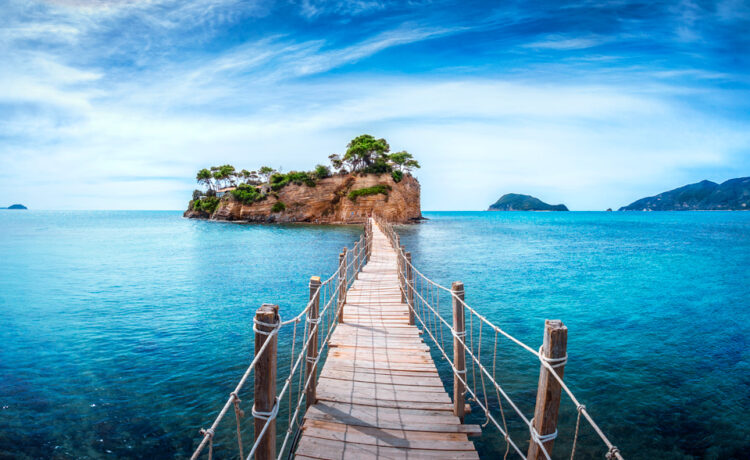-
1.Navagio(Shipwreck)
In the northeast of Zakynthos is a cove embraced by towering white limestone cliffs.
Beneath them on the white beach are the rusting remains of the MV Panagiotis, a container ship that ran aground in 1980. There are two ways to experience this awe-inspiring natural sight: From above you can drive or catch a tourist bus to Navagio Beach View and queue up for what must be the island’s most emblematic scene, of the shipwreck and the cove’s glowing blue water far below.
By sea, you could charter your own boat if you want to be independent, or board a tourist cruise from Porto Vromi, Agios Nikolaos Port in Volimes or Zakynthos Town on the east coast.
If you don’t mind crowds you can sunbathe on the beach, swim in the ethereal water, marvel at the cliffs and explore the wreck.
2.Kalamaki
One of a few beaches that we’ll mention in the Greek National Marine Park, Kalamaki is on the eastern pocket of Laganas Bay and could be the best on the island.
The coastline is protected, which keeps tourist development discreet and away from the beach.
There’s nothing more than a single bar renting out parasols and sun loungers.
And as you’re in a national park, the beach is diligently maintained.
The golden sand is spotless, while the beach shelves very gradually to warm, transparent waters.
On the shore you’ll see swimmers hundreds of metres out as the sea is so calm and shallow in this bay.
3. Blue Caves
The little harbour at Skinari in the very north of Zakynthos is the point of departure for trips to the Blue Caves, also only accessed by water.
Within minutes you’ll be floating through a magnificent set of limestone sea caves and natural arches.
There’s nothing accidental about the name of these formations as the water has what can only be described as a shade of milky blue, caused by the interplay of the sun and the white limestone.
You’ll be allowed to jump in for a swim and don’t be alarmed to see your skin turn a ghostly hue under the surface.
4. Porto Limnionas Beach
A newly laid road from the village of Agios Leon weaves down to this fjord on the west coast, bounded on its east side by high white cliffs hollowed with caves.
Resting above the fjord on the western slope is a taverna with tables and sun loungers on terraces where you gaze into the pristine blue water.
Further down are rocks and concrete platforms where people lay their towels, and you’ll find it hard to resist bathing in the shimmering, crystalline water and stepping onto the tiny beach at the northern end.
5. Marathonisi
This islet in Laganas Bay in the south of Zakynthos is often called Turtle Island, as it’s a hatching ground for the loggerhead sea turtle.
For that reason Marathonisi is uninhabited and visitors have to clear the sandy beach to the north before sunset in summer to allow the turtles to come ashore to lay their eggs.
At the southern harbours of Limni Kerio and Laganas, you can embark on turtle-spotting cruises to the island, normally on a glass-bottom boat.
The clarity of the water means you’ll have a good chance of seeing one or two.
You’ll be given up to an hour on the island to sunbathe, swim and have a picnic in this unspoiled setting.
6. Agios Dionisios Church
The relics of St Dionysios, the island’s patron saint are kept at this church right on the harbour in Zakynthos Town where they have been since 1717. His reliquary is carried around the town on his saint’s day, on August 24th, and the sarcophagus is opened daily just before noon for worshippers.
The original church was razed by an earthquake in 1893, this reconstructed building dates to 1948 and was one of the few left standings after the earthquake in 1953. In the classic neo-Byzantine style the barrel vault and walls of this St Dyonisios are decorated with frescoes, like the Panagia of the Madonna and infant Jesus in the apse.
The church museum has four works by the eminent 18th-century painter Nikolaos Koutouzis.
7. Keri Caves
At the villages on the south coast like Limni Kerio, Agios Sostis and Laganas you can book a boat tour along the indented coastline in the far south of the island.
The white cliffs soar to 300 metres and at their base are small sea caves and natural arches.
At once the boat will lower a ladder for you to swim in the sea, which has a radiance caused by the purity of the water and the sun hitting the white rocks.
You can swim into the caves to look around, and might be amazed to learn that the sea is at least 20 metres deep at the base of the cliffs.
The Keri Caves are often included as a stop on turtle-spotting excursions to Marathonisi.
8. Banana Beach
The longest beach on Zakynthos is also one of the most alluring, for its soft golden sand and shallow transparent sea.
Banana Beach is in the Greek National Marine Park in the southeast of the island, but that doesn’t mean that there’s an absence of facilities.
For almost the whole length you can hire sun loungers, or your own beach pergola if you’re feeling decadent.
These are all rented out by the Banana Casa Playa bar and restaurant, which lays on full service.
On the eastern end, there’s a watersports centre for activities like parasailing, jet skiing and waterskiing.
9. Anafonitria Monastery
A stone’s throw from Navagio is a monastery from the island’s Byzantine period, consecrated in the middle of the 15th century and unharmed by the earthquake of 1953. Saint Dionysios, the patron saint of Zakynthos resided here at the end of his life in the 1500s.
The monastery has a quaint stone tower, originally built to defend the complex but later turned into a campanile.
The church is embellished with stunning if slightly time-worn hagiography.
Maybe the most photogenic spot in the courtyard, with free-standing columns, fruit trees, palms and flowers, growing in pots and vines creeping up the rustic stone walls.
10. Panagia Skopiotissa Monastery
Panagia Skopiotissa Monastery Source: Damian Czajka / shutterstock
Panagia Skopiotissa Monastery
Resting atop Mount Skopos in the southeast of Zakynthos, the Panagia Skopiotissa Monastery is a gruelling climb worthwhile for its 15th-century church and the exhilarating scenery.
The church walls are coated with frescoes and there’s an icon of the Virgin Mary produced in Constantinople and brought to Zakynthos after it was taken by the Ottoman Empire.
On the floor of the church, you won’t help but notice the double-headed eagle, an emblem for the Byzantine Empire.
A lot of the joy of the monastery is the journey there, as you can hike up a winding path from the coastal resort of Kalamaki.
When the sun is glaring in mid-summer, you can always drive up the snaking mountain road from Argassi to the north.
11. Gerakas Beach
The southernmost beach on Zakynthos is also one of the loveliest and has a western-facing curve of golden sand lapped by pure turquoise waters.
Behind the beach are precipitous sandy hills that get rockier at each end.
Looking towards the south, there’s a majestic promontory with bare rock layered red and white.
This more secluded end is also favoured by naturists.
One section of the Gerakas Beach is cordoned off, as loggerhead sea turtles use the beach as a nesting site.
These creatures mate during early summer and their eggs tend to hatch throughout the high season.
If you get up before dawn you’ll be able to watch hundreds of baby turtles shuffling to the water from the beach.
12. Byzantine Museum
In an arcaded mansion pointing out to sea on Solomos Square, the Byzantine Museum is a repository of Byzantine and post-Byzantine religious art from around the island.
From the Byzantine period, there are frescoes, icons and wood carvings.
But the museum also has paintings, vestments, crucifixes and many more liturgical artifacts from the 15th to the 17th centuries.
Some of these were produced outside of Zakynthos and brought to the island when it was under Ottoman rule.
Elsewhere a scale model of the city and black and white photographs give you glimpses of how Zakynthos looked before the catastrophic earthquake of 1953.
13. Keri Lighthouse
Near the far south of Zakynthos, this lighthouse atop a 300-metre cliff is only part of the attraction.
A restaurant sits on the cliff-top and from its terrace, you’ll be treated to a very romantic perspective of the deep blue Ionian Sea, the cliffs and the outcrops at their base.
And as the terrace points, west the sunsets are magical here.
The restaurant also has a small overhanging skywalk if you have a stomach for heights.
Naturally, all this comes with the cost of a meal or drinks.
But if you’d prefer to take in the view without paying you can carry on down the road for another vantage point to write home about.
14. Askos Stone Park
In the very north of Zakynthos is an attraction that rolls a wildlife sanctuary, zoo, farm, forest reserve and archaeological site into one.
The park is named for the profusion of stone structures around, from the paving stones to the drystone walls, stone-built stables and the remarkable cisterns cut from the cliffs and dating back six centuries.
For kids, the best bit will be meeting and feeding animals like ponies, deer, peacocks, raccoons, chinchillas, turtles, goats, rabbits and pigs.
The farm is also planted with orchards for peaches and apples, grown without pesticides.
Depending on the season you may be able to get down to some rural activities like harvesting olives or milking a cow.
15. Aristeon Olive Press & Museum
Zakynthos is prized for its olive oil and this free museum a few kilometres from the airport will tell you everything you need to know.
The tour begins in the 1700s, with a collection of antique implements like a wooden press and grindstones that were once powered by animals.
You can contrast these with the state-of-the-art factory and its stainless steel vats and centrifuge.
On the way, your guide will fill you in on some olive oil facts and point out the difference between virgin and extra virgin olive oil.
At the tasting session, there’s homemade bread to dip in Aristeon’s oil, and a factory shop selling olive oil soap and garlic and lemon infused oils.
16. Xigia (Sulfur waters)
Xigia beach is a picturesque pebbly beach that is unique on the island due to the water having high sulphur content, giving the beach a distinctive sulphuric aroma.
The sulphur comes from a nearby cave and this beach is a great place for anyone with aches, pains and arthritis to bathe as the sulphur in the water helps ailments.
It is also reputed to be good for skin problems and helps remove cellulite. This beach is easily accessible by car and parking is available nearby.
There are a handful of good tavernas in the vicinity although there are no facilities actually on the small beach, so make sure you take water and other necessities with you.


